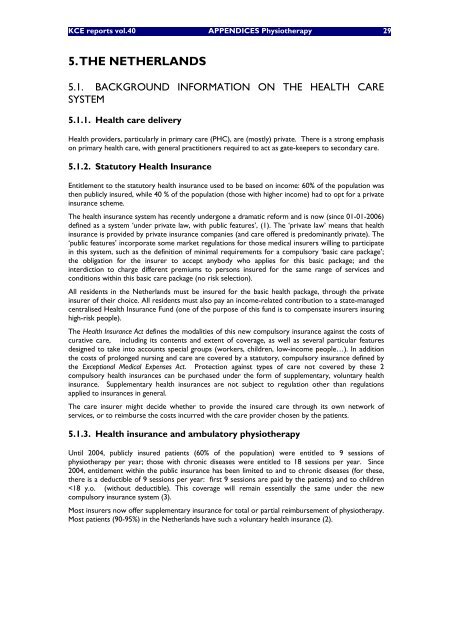Download the supplement (208 p.) - KCE
Download the supplement (208 p.) - KCE
Download the supplement (208 p.) - KCE
Create successful ePaper yourself
Turn your PDF publications into a flip-book with our unique Google optimized e-Paper software.
<strong>KCE</strong> reports vol.40 APPENDICES Physio<strong>the</strong>rapy 29<br />
5. THE NETHERLANDS<br />
5.1. BACKGROUND INFORMATION ON THE HEALTH CARE<br />
SYSTEM<br />
5.1.1. Health care delivery<br />
Health providers, particularly in primary care (PHC), are (mostly) private. There is a strong emphasis<br />
on primary health care, with general practitioners required to act as gate-keepers to secondary care.<br />
5.1.2. Statutory Health Insurance<br />
Entitlement to <strong>the</strong> statutory health insurance used to be based on income: 60% of <strong>the</strong> population was<br />
<strong>the</strong>n publicly insured, while 40 % of <strong>the</strong> population (those with higher income) had to opt for a private<br />
insurance scheme.<br />
The health insurance system has recently undergone a dramatic reform and is now (since 01-01-2006)<br />
defined as a system under private law, with public features , (1). The private law means that health<br />
insurance is provided by private insurance companies (and care offered is predominantly private). The<br />
public features incorporate some market regulations for those medical insurers willing to participate<br />
in this system, such as <strong>the</strong> definition of minimal requirements for a compulsory basic care package ;<br />
<strong>the</strong> obligation for <strong>the</strong> insurer to accept anybody who applies for this basic package; and <strong>the</strong><br />
interdiction to charge different premiums to persons insured for <strong>the</strong> same range of services and<br />
conditions within this basic care package (no risk selection).<br />
All residents in <strong>the</strong> Ne<strong>the</strong>rlands must be insured for <strong>the</strong> basic health package, through <strong>the</strong> private<br />
insurer of <strong>the</strong>ir choice. All residents must also pay an income-related contribution to a state-managed<br />
centralised Health Insurance Fund (one of <strong>the</strong> purpose of this fund is to compensate insurers insuring<br />
high-risk people).<br />
The Health Insurance Act defines <strong>the</strong> modalities of this new compulsory insurance against <strong>the</strong> costs of<br />
curative care, including its contents and extent of coverage, as well as several particular features<br />
designed to take into accounts special groups (workers, children, low-income people ). In addition<br />
<strong>the</strong> costs of prolonged nursing and care are covered by a statutory, compulsory insurance defined by<br />
<strong>the</strong> Exceptional Medical Expenses Act. Protection against types of care not covered by <strong>the</strong>se 2<br />
compulsory health insurances can be purchased under <strong>the</strong> form of <strong>supplement</strong>ary, voluntary health<br />
insurance. Supplementary health insurances are not subject to regulation o<strong>the</strong>r than regulations<br />
applied to insurances in general.<br />
The care insurer might decide whe<strong>the</strong>r to provide <strong>the</strong> insured care through its own network of<br />
services, or to reimburse <strong>the</strong> costs incurred with <strong>the</strong> care provider chosen by <strong>the</strong> patients.<br />
5.1.3. Health insurance and ambulatory physio<strong>the</strong>rapy<br />
Until 2004, publicly insured patients (60% of <strong>the</strong> population) were entitled to 9 sessions of<br />
physio<strong>the</strong>rapy per year; those with chronic diseases were entitled to 18 sessions per year. Since<br />
2004, entitlement within <strong>the</strong> public insurance has been limited to and to chronic diseases (for <strong>the</strong>se,<br />
<strong>the</strong>re is a deductible of 9 sessions per year: first 9 sessions are paid by <strong>the</strong> patients) and to children<br />
















